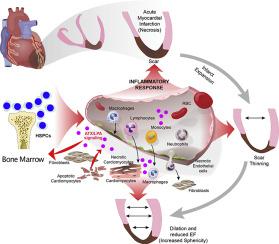Journal of Molecular and Cellular Cardiology ( IF 5 ) Pub Date : 2020-10-02 , DOI: 10.1016/j.yjmcc.2020.09.011 Himi Tripathi 1 , Ahmed Al-Darraji 1 , Mohamed Abo-Aly 1 , Hsuan Peng 1 , Elica Shokri 1 , Lakshman Chelvarajan 1 , Renee R Donahue 1 , Bryana M Levitan 1 , Erhe Gao 2 , Gabriela Hernandez 1 , Andrew J Morris 1 , Susan S Smyth 1 , Ahmed Abdel-Latif 1

|
Objective
Acute myocardial infarction (AMI) initiates pathological inflammation which aggravates tissue damage and causes heart failure. Lysophosphatidic acid (LPA), produced by autotaxin (ATX), promotes inflammation and the development of atherosclerosis. The role of ATX/LPA signaling nexus in cardiac inflammation and resulting adverse cardiac remodeling is poorly understood.
Approach and results
We assessed autotaxin activity and LPA levels in relation to cardiac and systemic inflammation in AMI patients and C57BL/6 (WT) mice. Human and murine peripheral blood and cardiac tissue samples showed elevated levels of ATX activity, LPA, and inflammatory cells following AMI and there was strong correlation between LPA levels and circulating inflammatory cells. In a gain of function model, lipid phosphate phosphatase-3 (LPP3) specific inducible knock out (Mx1-Plpp3Δ) showed higher systemic and cardiac inflammation after AMI compared to littermate controls (Mx1-Plpp3fl/fl); and a corresponding increase in bone marrow progenitor cell count and proliferation. Moreover, in Mx1- Plpp3Δ mice, cardiac functional recovery was reduced with corresponding increases in adverse cardiac remodeling and scar size (as assessed by echocardiography and Masson's Trichrome staining). To examine the effect of ATX/LPA nexus inhibition, we treated WT mice with the specific pharmacological inhibitor, PF8380, twice a day for 7 days post AMI. Inhibition of the ATX/LPA signaling nexus resulted in significant reduction in post-AMI inflammatory response, leading to favorable cardiac functional recovery, reduced scar size and enhanced angiogenesis.
Conclusion
ATX/LPA signaling nexus plays an important role in modulating inflammation after AMI and targeting this mechanism represents a novel therapeutic target for patients presenting with acute myocardial injury.
中文翻译:

抑制自分泌运动因子减少心脏炎症并减轻心肌梗塞后的不良心脏重构
客观的
急性心肌梗死 (AMI) 引发病理性炎症,加重组织损伤并导致心力衰竭。自分泌运动因子 (ATX) 产生的溶血磷脂酸 (LPA) 会促进炎症和动脉粥样硬化的发展。ATX/LPA 信号传导关系在心脏炎症和由此产生的不良心脏重塑中的作用知之甚少。
方法和结果
我们评估了与 AMI 患者和 C57BL/6 (WT) 小鼠的心脏和全身炎症相关的自分泌运动因子活性和 LPA 水平。人和鼠外周血和心脏组织样本显示 AMI 后 ATX 活性、LPA 和炎症细胞水平升高,并且 LPA 水平与循环炎症细胞之间存在很强的相关性。在功能获得模型中,与同窝对照 (Mx1-Plpp3 fl/fl )相比,脂质磷酸酶-3 (LPP3) 特异性诱导敲除 (Mx1-Plpp 3 Δ ) 在 AMI 后表现出更高的全身和心脏炎症;以及骨髓祖细胞计数和增殖的相应增加。此外,在 Mx1-Plpp3 Δ小鼠,心脏功能恢复减少,不良心脏重塑和疤痕大小相应增加(通过超声心动图和马森三色染色评估)。为了检查 ATX/LPA 连接抑制的效果,我们用特定药理学抑制剂 PF8380 治疗 WT 小鼠,每天两次,持续 AMI 后 7 天。抑制 ATX/LPA 信号联系导致 AMI 后炎症反应显着减少,导致有利的心脏功能恢复,减少疤痕大小并增强血管生成。
结论
ATX/LPA 信号连接在调节 AMI 后的炎症中起重要作用,针对这种机制代表了急性心肌损伤患者的新治疗靶点。


























 京公网安备 11010802027423号
京公网安备 11010802027423号